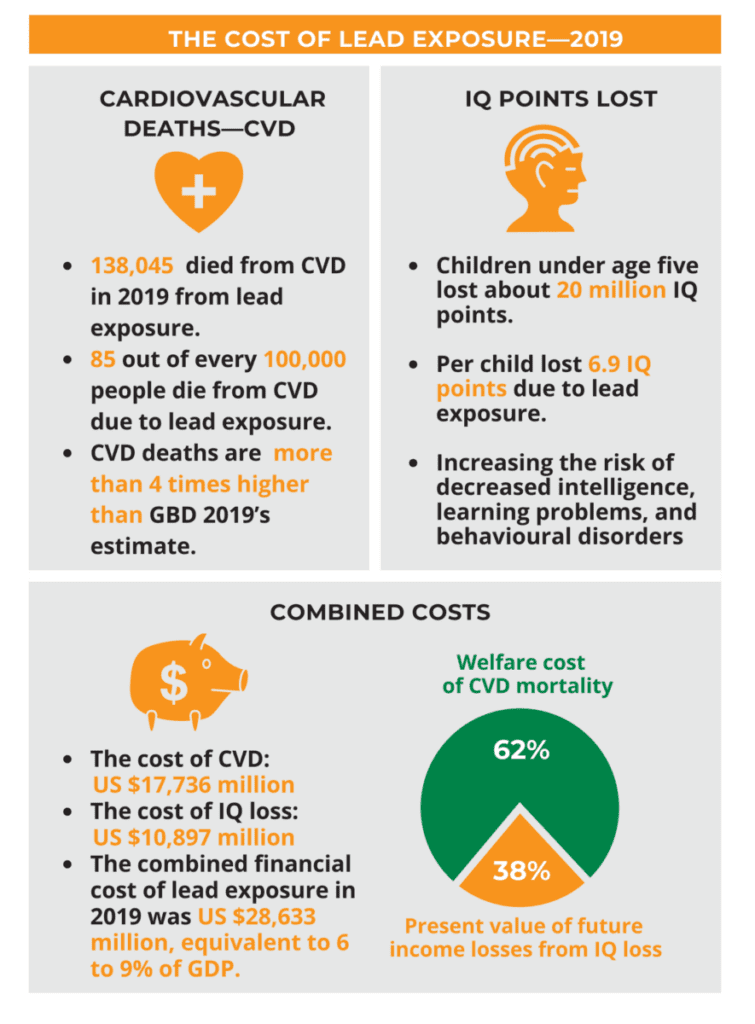
New studies reveal devastating new data on lead pollution in Bangladesh, the fourth most lead pollution-impacted country in the world. Learn more in this post by Mitali Das, Communications Lead, and Bushra Humaira Sadaf, Senior Communications Manager, Pure Earth Bangladesh.
—
Lead Pollution is not a topic we hear about every day in the newspapers, on television, or on the internet. Yet, unbeknownst to us, we are being exposed to it every day. Recent research has brought to light the alarming scale of its influence on our health. This newfound knowledge is reshaping our perception of this widespread threat.
The Wake-Up Call
A groundbreaking new study, published in the Lancet Planetary Health journal in September 2023, titled “Global health burden and cost of lead exposure in children and adults: a health impact and economic modeling analysis,” has brought to light the devastating consequences of lead pollution. Conducted by two World Bank specialists, Bjorn Larsen and Ernesto Sánchez-Triana, this research outlines shocking revelations for the world, as well as Bangladesh.
Contrary to previous estimates, lead pollution is not just a minor concern; it is a major health crisis for Bangladesh and globally. Bangladesh, the fourth most lead pollution-impacted country in the world, is facing a significant Intelligence quotient (IQ) loss among children and a rise in cardiovascular disease (CVD) deaths among adults due to lead pollution. The report estimates that the level of harm due to lead exposure is far greater than previous estimates.
A Shattering Impact on Health
The most startling revelation from the study is the estimated death toll attributed to lead exposure. It’s not merely a few isolated cases; lead pollution potentially globally contributes to over 5 million deaths annually and 75 million Intelligence quotient (IQ) points loss among children. The majority of the burden and cost of lead exposure is on low-and-middle-income countries (LMICs), where about 90% of CVD deaths and 95% of IQ point losses are caused due to lead exposure. To put that in perspective, it’s a death toll that rivals the global threat of air pollution.
Loss of IQ, Increasing the Risk of Intellectual Disabilities among the Children
The impact of lead pollution extends beyond mortality rates. The study reveals that the average blood lead level in children and adults is 6.8 micrograms per decilitre (ug/dL) in Bangladesh. Such high blood lead levels (BLL) are causing a loss of an average of 6.9 IQ points among children due to lead exposure.
Globally, Bangladesh holds the eighth position in terms of loss of IQ, which is increasing the risk of intellectual disabilities among children. According to the study, lead pollution has serious implications for children under five, causing a loss of about 20 million (20,596,306) IQ points. This isn’t just a statistic; it represents a future robbed of potential and opportunity for these young children. Childhood lead poisoning increases the risk of decreased intelligence in children, learning problems, and behavioral disorders. The consequences of IQ loss are far-reaching, impacting children’s academic performance, future job prospects, and overall quality of life.
Bjorn Larsen, who conducted this research said, “Our study indicates that the damaging health effects of lead are much greater than we previously thought and that they come at a very high economic cost, especially in low-middle-income countries. We have estimated for Bangladesh that about 20 million IQ points are lost among young children every year, equivalent to over the first 5 years of a child’s life. This is very substantial and has enormous implications for a child’s learning capacity, schooling, as well as lifetime income of the child, and productivity of the child in the labor force.”
Cardiac Deaths Among Adults
The last available 2019 Global Burden of Disease (GBD) data, published in May 2022, showed that about 30,000 people die annually due to lead pollution in Bangladesh. The recent study in The Lancet revealed that there are 138,054 CVD deaths among adults aged 25 years or older due to lead exposure in Bangladesh. This new estimate is four times the mortality rate of the previous figure.
Chronic exposure to lead can cause the accumulation of this toxic metal in the body over time, adversely affecting the cardiovascular system. Lead exposure can also contribute to the development of atherosclerosis, a condition where arteries become narrowed and hardened due to plaque buildup, further increasing the risk of heart-related illnesses. The findings indicate that lead exposure may be the third largest risk factor for cardiovascular disease mortality, exceeded only by high blood pressure and diet risks, ahead of tobacco smoking and high cholesterol.

The Economic Toll
The consequences of lead pollution are not limited to health, they also extend to the economy. The IQ loss of children is causing a very high economic cost of US$10,897 million, which is 3.6 percent of Bangladesh’s annual GDP. And the loss of lives due to CVD costs US$17,736 million, which is equal to 5.86% of the country’s GDP.
In 2019, the combined cost of these health effects in Bangladesh was US$28,633 million, which is a loss of 6 to 9% of the country’s GDP.
The researchers estimate that lead exposure cost the world a staggering $6 trillion in 2019, equivalent to 7% of the global GDP. This economic burden underscores the urgent need to address this issue comprehensively.
The Sources of Lead Exposure
Historically, leaded gasoline was recognized as a significant source of lead exposure and was banned in Bangladesh in 1999. Yet, there remains several sources of lead around us. In Bangladesh, the major sources of lead exposure include used-lead acid battery recycling in informal settings, leaded paint, aluminum cookware, ceramic food ware, spices, toys, cosmetics, food, electronic waste, fertilizers, and cultured fish feed. We unknowingly keep on encountering this toxic metal in everyday life.
In a recent global assessment by Pure Earth published in September 2023, 197 samples of consumer products from three districts in Bangladesh were analyzed as part of the Rapid Market Screening study. 24 percent of the 197 samples exceeded the reference level of lead concentration. Metal food ware (59 percent), ceramic food ware (44 percent), and paint (54 percent) had a particularly high percentage of samples exceeding the reference values. This research assessed lead concentrations in more than 5,000 samples of consumer goods and foods from markets across 25 low- and middle-income countries to understand the extent of lead contamination in our daily products.
Dr. Mahfuzar Rahman, Bangladesh Country Director of Pure Earth stated, “Given the profound health and economic toll inflicted by lead exposure in Bangladesh, safeguarding the environment must become a top priority. Pure Earth’s Rapid Market Screening analysis of about 200 items in three districts showed the widespread sources of lead in daily commodities such as metallic food ware, ceramic food ware, paint, rice/starch, and toys, posing potentially serious health risks. Strict regulations and increased investments are imperative to further research and the implementation of risk reduction strategies.”
Invest in Solving Lead Pollution
The lack of resources allocated to addressing lead pollution is concerning. Diseases like malaria, HIV/AIDS, and tuberculosis receive large amounts of funding compared to lead exposure. Lead affects millions and leads to significant health and economic consequences but receives comparatively little attention and investment. Research shows a very high return on investment for cost-effective lead interventions, as much as $20,000 for every $1 invested. Government and funding organizations should understand that lead pollution poses a grave threat to all of us.
Ana Luisa Lima, Senior Environmental Specialist from the World Bank, said “The information we already have in our hands is enough to create this awareness that this is a real problem. In the meantime, we can take some provisional measures until we get more data. We could conduct iron supplementation in children, site remediation of contaminated sites, and control the management of cookware, as some cookware, especially aluminum, could be a potential source.”
The Call to Action: 10-Point Action Plan
The new studies serve as stark reminders of the hidden danger that lead pollution poses to our health and well-being. It’s a wake-up call to governments, policymakers, and individuals. ‘Lead-safe Bangladesh Coalition’ is an alliance of organizations in Bangladesh, which comprises members from NGOs, INGOs, the UN, researchers, academics, and environmental health experts. Coalition members expressed their concerns and urged the government and policymakers to take immediate action following their suggested ten-point action plan to address the lead pollution crisis.
- Source Analysis: Expand identification of lead-contaminated sites and sources of lead in products and the food supply chain.
- Specific Interventions: Conduct further research to eliminate the use of lead in industrial and decorative paints and enforce laws to shut down informal lead-acid battery operations.
- Blood Lead Level Surveillance: Strengthen the lab capacity for blood lead level surveillance and conduct national blood lead level measurements.
- Multi-Sectoral Efforts: Develop a national multi-sectoral strategy and action plan to address lead poisoning.
- Increase Monitoring: Monitor the import and export of lead-containing products.
- Policy Review and Advocacy: Develop or review national policies and operational plans to address lead exposure based on identified sources.
- Raise Public Awareness: Launch national awareness campaigns to address lead exposure.
- Remediate Toxic Sites: Invest in the cleanup of contaminated sites to protect children and pregnant women.
- Capacity Building: Train healthcare professionals to strengthen the diagnosis and management of childhood lead exposure.
- Regulatory Compliance: Ensure that the private sector complies with regulations and standards for safe production and disposal of lead in products.
Lead pollution is not a problem of the past but a pressing issue that demands immediate attention. It’s time for governments, industries, and individuals to work together to eliminate this silent killer and safeguard the health and future of our global community. These new studies should serve as a red alert for a concerted effort to address the far-reaching consequences of lead pollution. The world can no longer afford to turn a blind eye to this hidden threat.
Read more:
- Global health burden and cost of lead exposure in children and adults: a health impact and economic modeling analysis, by the World Bank published in The Lancet Planetary Health.
- Summary of Lancet Study – Impact of Lead Pollution in Bangladesh
- Lead in Consumer Goods: A 25 Country Analysis of Lead (Pb) Levels in 5,000+ Products and Foods, a Rapid Market Screening study by Pure Earth.
- Infographic: Rapid Market Screening in Bangladesh



